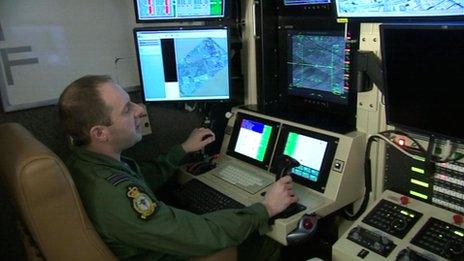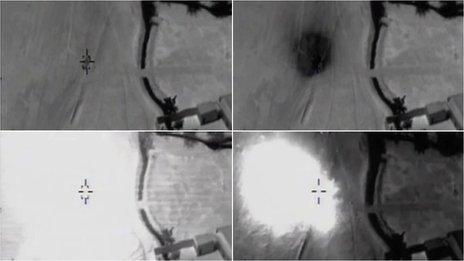Inside Britain's military drone base at RAF Waddington
- Published
Jonathan Beale talks to the RAF about drones
What is in a name? Quite a lot according to the RAF. What you and I may call a drone is, it insists, a remotely piloted air system or unmanned aerial vehicle. The fuss over what to call them is just one sign of the controversy surrounding their use.
Since earlier this year, the RAF has been flying "RPAS" or "UAVS" over Afghanistan from an airbase in Lincolnshire. This is the first time the media has been allowed inside.
RAF Waddington is now effectively Britain's "drone headquarters". It is not something that has been universally welcomed.
There were protests outside the base when the MoD confirmed it was flying combat missions from Waddington. Before RAF crews were flying them from Nevada.
Some crews are still based there - and they all still rely on close American co-operation. The UK needs US military satellites to operate its drones.
Simulated mission
Waddington is now home to 13 Squadron which flies the Reaper - the only UK drone that is armed. It can carry Hellfire missiles or 500lb bombs. None are on show here.
The RAF's five Reapers are all in Afghanistan, with another five on order. But we are allowed to see the aircrew who operate the Reaper in action - or at least on simulated mission.
It seems a surreal existence. Waking up in Waddington and then flying combat missions in Afghanistan. They walk to work and step into their windowless cockpit.
It is a container fitted with banks of computers and screens. The three aircrew inside are only prepared to give their first names - something that is only likely to fuel suspicion or add to the mystique.
"Col", the pilot, has two control sticks in front of him to operate the plane that is flying thousands of miles from where he is sitting.
I ask him if he is ever had to fire the Reaper's Hellfire missiles. He says yes, but adds: "It's not something I like to talk about very often."
Rules of engagement

The RAF's drones are operated by qualified pilots

Pilots see images from a drone's cameras as they track and attack targets
The RAF is keen to challenge any impression that this is like some kind of hi-tech video game. The crew speak of their professionalism. They all learned to fly in the air first and insist that operating the Reaper is not that different.
Wing Cdr Damian Killeen, the commanding officer of 13 Squadron, spent 15 years piloting a Harrier jump jet. He says the Reaper gives him more information.
Not only does he have access to all sorts of imagery from the Reaper's cameras, he can also speak to troops on the ground or even a lawyer in the UK.
He insists the rules of engagement are the same as for any other pilot. He says firing his weapon "still fills you with apprehension".
The Ministry of Defence is anxious to show how carefully such decisions are taken. As well as opening up Waddington, they have released video from previous missions.

Wing Cdr Damian Killeen says flying a drone "still fills you with apprehension"
One shows how clearly a Reaper's camera can focus on an insurgent on the ground. Thousands of feet in the air it can even identify the weapon as it is being fired.
Another video shows a suspected insurgent hiding behind a wall before running into a compound. To prove that care is taken to avoid civilian casualties the Hellfire that has already been aimed at the suspect is diverted mid-flight to avoid the buildings and any collateral damage.
These are clearly carefully chosen video clips from thousands of hours of footage to prove a point.
PR deficit
Defence Secretary Philip Hammond admits there is one known incident of a British drone killing civilians in Afghanistan but he says that is one incident in more than 400 times when the Reaper has fired its weapons.
Sergeant Carl James Boyd shows how the Black Hornet Nano will be used for surveillance
Mr Hammond says he wants to "bust some myths" about the use of what he carefully refers to as remotely piloted air systems. He adds he is worried about the way the media has presented the subject.
Opening up Waddington is clearly a late effort to address the PR deficit. The military has also put on show other UAVs used for surveillance, ranging from tiny nano drones that hover close to troops on the ground, to the larger medium-altitude ones that can loiter in the air for more than 20 hours.
It is the future of warfare, even though it is unclear as to where they will fly once the mission in Afghanistan is over. There are still only a few remote parts of the UK where they are permitted to fly.
That is a battle for the future. The one that has tried to rename the drone as a remotely piloted air system has probably already been lost.
- Published27 April 2013
- Published27 April 2013